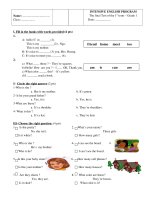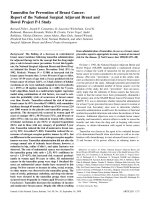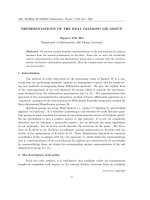Final Report of the Customer Satisfaction Work Group
Bạn đang xem bản rút gọn của tài liệu. Xem và tải ngay bản đầy đủ của tài liệu tại đây (509.14 KB, 16 trang )
1
Final Report of the
Customer Satisfaction Work Group
of the
Workforce Information Council
Section I – Executive Summary
The Customer Satisfaction Work Group (Work Group) of the Workforce
Information Council (WIC) was appointed to explore the issue of customer satisfaction as
it relates to labor market information (LMI) providers and users of the information. The
Work Group was composed of eleven members, two support personnel and a consultant.
They met formally three times between October 2002 and June 2003, and gave quarterly
updates to the WIC.
The Work Group utilized existing documents and gathered other reports to guide
its work. Many of the concepts employed are private sector marketing concepts. The
group verbalized the process of developing labor market information products and
services as being a process of data collection, data analysis and distribution of
information products and services. The process defined in this manner seems void of
customer satisfaction measurement and needs assessment. Therefore, the Work Group
concentrated on incorporating the needs and satisfaction of customers into the LMI
creation process.
Two models were constructed to demonstrate how customer satisfaction and
needs assessment can guide the creation of meaningful labor market information and
move toward a demand-driven workforce information system. One model charts a state
scenario and the other extends the model to federal products. The result is a dynamic,
customer-driven labor market and workforce information system which is responsive to
customer needs and wants in a changing environment. The process embraces not only
the concept of assessing customer satisfaction, but also of working (through evaluation
teams and the WIC) toward continuous improvement of the system. This is the objective
of the requirement to “consult” with customers as set forth in Section 309 of the
Workforce Investment Act of 1998.
As part of infusing customer satisfaction into the labor market information
development process, some critical components have been identified. They include:
• The establishment of evaluation teams in each state, charged with turning
customer satisfaction assessment results into improved products and services, and
with sharing customer satisfaction processes and improvements with other states
and federal agencies;
• Nine measurable attributes which the Work Group believes will lead to more
meaningful customer assessment activities and provide for easier information
sharing;
• A methodology that state and federal agencies can employ to “think through” the
customer satisfaction process. The methodology is displayed in a handbook
developed by the Work Group which will be made available to assist federal and
2
state agencies as they work to develop protocols and choose methods for
assessment;
• Strategies for documenting demand for labor market information products which
can provide guidance to funding agencies, in addition to encouraging broader use
of available information.
This document has five sections including this executive summary. Section II
outlines the Work Group’s approach to work. Section III discusses and models the
relationships between customer satisfaction and labor market information. Section IV
reviews pilot studies, and Section V of this document responds specifically to the charter
given to the Work Group by the WIC.
The response in Section V notes findings by the group and then provides seven
actionable recommendations. These recommendations include establishing or identifying
a customer satisfaction focal point for sustaining the effort and providing on-going
customer satisfaction technical assistance, offering training to agency representatives on
implementing customer satisfaction programs, exploring customer satisfaction as a
deliverable in the BLS cooperative agreement and continuing it as a deliverable in the
ETA core products grant, and expanding the efforts of the Work Group into a demand-
driven marketing effort for workforce information.
There are also attachments under various tabs. Tab III is a customer satisfaction
handbook. Tab IV reviews pilot study results. Tab V is the draft document “Workforce
Information Customer Satisfaction Assessment: A Primer for State and Local Planning”
developed by Mediacall, Inc. and the Heldrich Center. Tab VI documents BLS customer
satisfaction activities. Tab VII is the project work plan which set the course for the Work
Group. Tab VIII is feedback information from federal agencies on their customer
feedback programs. Tab IX is a tally of state customer satisfaction activities, and Tab X
is the first progress report of the Work Group.
3
Section II – Approach to Work
Introduction
The Customer Satisfaction Work Group (Work Group) of the Workforce Information
Council (WIC) was appointed to explore the issue of customer satisfaction as it relates to
labor market information providers and users of the information. The WIC defined the
scope of the Work Group by providing a charter with five specific outcomes:
1. What are the broad parameters for a customer satisfaction measurement system?
2. What customers and products/services should the system address?
3. How should the activities related to customer satisfaction measurement be
communicated to state LMI offices and state employment statistics agencies?
How can their support for the effort be encouraged?
4. What technical assistance should be provided to states in implementing customer
satisfaction measurement within their states?
5. How should customer satisfaction measurement be incorporated into federal
funding agreements for LMI activities?
The Work Group was composed of eleven members, two support personnel and a
consultant, including:
• Olaf Bjorklund, Employment and Training Administration, Federal Co-chair
• James McFadden, Chief, Office of Occupational and Labor Market Information,
Delaware Department of Labor, State Co-chair
• Garry Breedlove, Florida Agency for Workforce Innovation
• Tom Gallagher, Manager, Research and Planning, Wyoming Department of
Employment
• Rod Fortran, New York Department of Labor, Division of Research and Statistics
• Yolanda Harris, Marketing Communication Specialist, Illinois Department of
Employment Security
• Betty McGrath, Economist, North Carolina Employment Security Commission
• Peter Phelan, Center For Workforce Information and Analysis, Pennsylvania
Department of Labor and Industry
• Mary Ann Regan, Director, Center for Workforce Information and Analysis,
Pennsylvania Department of Labor and Industry
• Vivian Shapiro, Assistant Commissioner, New Jersey Department of Labor
• Stanley Stephenson, San Francisco Regional Commissioner, Bureau of Labor
Statistics
Support Staff
• Dixie Sommers, Center on Education and Training for Employment, Ohio State
University
• Nancy Pyon, Center on Education and Training for Employment, Ohio State
University
4
Consultant
• Don Norton, Vice President, Mediacall Marketing and Advertising, Inc.
The Work Group began meeting quarterly with the consultant in October 2002. Other
meetings were held in January and May 2003. The WIC was apprised of status of the
project at meetings in December 2002, March and June 2003. A presentation was made
on the Work Group efforts at the BLS LMI conference in May 2003.
Several documents were used to guide the effort. Some of the documents were
developed by staff specifically for the project and others were collected to build in
previous efforts. These documents include:
1. A draft “Customer Satisfaction Primer,” funded by the ETA and written
by Mediacall and the Heldrich Center for Workforce Development at
Rutgers. This document also notes what actions states are implementing,
as well as private sector customer satisfaction practices;
2. A report from the Bureau of Labor Statistics (BLS) on the type of
customer satisfaction activities it has undertaken;
3. A “Project Work Plan” developed by the Work Group;
4. Examples of “Customer Feedback Information” collected from federal
agencies; and
5. Tally of Customer Satisfaction Activities currently being undertaken by
states.
Copies of these documents are attached as appendices to this document.
Similarly, the group developed a report at the mid-point of the process to document
resources. It is also attached as “Report 1.”
5
Approach to Work
The Work Group began to approach customer satisfaction with concepts set forth
in the Primer, noted above. The group set forth working definitions. These include:
o Customer satisfaction: meeting or exceeding the expectations of the
customer. It is recognized that there may be many attributes to satisfying
the customers.
o Customer expectations: attributes that are in the mind of the customers,
and consist of all parameters of what they, the customers, need, want and
think they need and want.
o Customer feedback: information gathered from the customers to assess
their level of satisfaction.
There were many discussions of “marketing” as it relates to labor market
information. The group embraced the concept of marketing as a process. In the private
sector, the process involves conducting research (listening to the customer to ascertain
needs and wants), developing products to meet those needs, promoting products, and then
re-evaluating product effectiveness. Products are changed through innovation or
discontinued, as noted below.
6
The group verbalized the process of developing labor market information
products and services as being a process of data collection, data analysis and distribution
of information products and services. The process has not historically recognized the
customer as part of the development process, as noted below.
LMI Product Development Model
Section 309 of the Workforce Investment Act of 1998 clearly mandates that
customer satisfaction data be gathered in an effort to continuously improve the LMI
system. The Work Group has been keenly aware of this mandate, and worked toward
developing a model which could incorporate private sector concepts into the labor market
information creation process.
In that regard, the group was less concerned with a process that developed a
single number for measuring satisfaction. Rather, the group focused on ways to collect
information regarding how labor market information products can be improved to better
meet the needs of users. The resultant model could be seen as follows:
Integrating Customer Satisfaction into LMI Product Development









